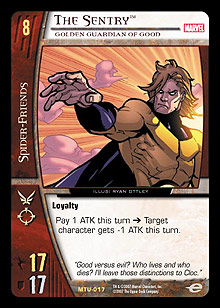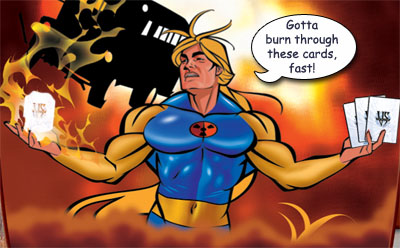
|
The Sentry™
Card# MTU-017


While his stats aren’t much bigger than those of the average 7-drop, Sentry’s “Pay ATK” power can drastically hinder an opponent’s attacking options in the late game.
Click here for more
|
|
|

|
|
|

 |
 |
|
|
| |

Last week, I reviewed the back-story of the design directions for the Thunderbolts team. This week, I’ll cover the zero hand and breakthrough replacement themes for the Squadron Supreme. To the best of my recollection, both of these themes were part of my initial presentation to the R&D team during the early design discussions. I think the zero hand direction didn’t fully evolve until the second meeting, after we had discussed what we wanted the Reservist mechanic to be doing.
When we introduce any new keyword, design always looks for ways to feature the new mechanic around what the different teams are trying to do. This allows us to open up design space and shows off all the avenues of interaction the new mechanic can provide players with.
On its most basic level, the Reservist mechanic allows players to safely put characters into their resource row, with the ability to recruit them later in the game. During the early turns of a game, if a player doesn’t draw enough plot twists, the Reservist mechanic takes away some of the guesswork as to whether the player will be lucky enough to pull a replacement character on later turns.
I knew I wanted to have a team feature a mechanical theme that interacted with Reservist beyond its basic curve-smoothing features. By allowing players to recruit characters that had been played as resources, I observed that Reservist cards turned the resource row into a secondary hand. This would allow players to “bank” certain cards in a secondary zone where they would be safe from hand disruption effects but vulnerable to resource disruption effects.
As I have mentioned in previous articles, when creating new mechanical themes, designers will frequently look at core game mechanics that may have been underexploited in terms of design space. Since day one, players could play plot twists from their hand but rarely did so. I started looking at what it would mean if there was a deck design where a player wanted to be recruiting characters from their resource row and playing plot twists from their hand. If design could make it interesting and development could balance it, it would be a whole new way to play the game.
Putting this all together into a cohesive design direction, I crafted the first series of cards that would eventually become the foundation for the zero hand theme. This was just the beginning of the process, however. There were two big development obstacles that would have to be overcome before the cards could be integrated into the set. The first was determining how easy or difficult it should be for a player to get his hand down to zero cards, and the second was the power level of the cards in play once the player accomplished this goal.
In the initial design file, I was very aware of the number of “enabler” cards I included in the set to help the player get his hand down to zero cards. I didn’t want any single card effect that allowed for multiple discards, but I wanted enough enabler cards at common to allow for the build to be viable in draft and potentially in Sealed Pack.
The zero hand theme was one of the first decks I attempted to draft during testing. I was anticipating every pass, eagerly looking for cards that both allowed me to discard and rewarded me for having no hand. In the earliest test drafts, it was good to be the Squadron zero hand player. This changed later in the process, though, once Yip and Humphreys caught on. By caught on, I mean that they began changing . . . er . . . “developing” . . . the cards in this cycle. I had a blast playing the deck, and I found the decisions about what to keep in my hand, what to discard from my hand, and what to put in my resource row to be both interactive and a lot of fun. After the first draft, I was still a little concerned that the pool might not have enough discard enablers at certain common points.
I was re-educated on this point during a later draft with Andrew Yip, who was using the deck against me. It was turn 5, and he had Albert Gaines ◊ Nuke in play. I looked at his hand, and he still had 5 cards in it. Looking at the board, I wasn’t seeing any discard enablers that would allow him to dump his hand. I knew he had some plot twists in his hand but I honestly didn’t think he had 5, as I could see multiple face-up plot twists in his resource row. So, I did some mental calculations, and decided that even if he did manage to drop his hand, I still had enough tricks to take down Albert Gaines ◊ Nuke.
 That’s when he powered-up from his hand three times, and played a few other tricks. Needless to say, I got wrecked. I had completely overlooked the possibility of him having so many duplicate characters in his hand, and using powering-up as yet another method of getting to zero cards. After that game, I stopped worrying so much about the number of discard enabler cards in the set at common. What I did end up doing was including a few cards like Hibernaculum and Skymax that allowed Squadron players to use their KO’d pile as another “bank” area to keep cards safely stored outside of their hands until they were needed in later turns. That’s when he powered-up from his hand three times, and played a few other tricks. Needless to say, I got wrecked. I had completely overlooked the possibility of him having so many duplicate characters in his hand, and using powering-up as yet another method of getting to zero cards. After that game, I stopped worrying so much about the number of discard enabler cards in the set at common. What I did end up doing was including a few cards like Hibernaculum and Skymax that allowed Squadron players to use their KO’d pile as another “bank” area to keep cards safely stored outside of their hands until they were needed in later turns.
Speaking of Albert Gaines ◊ Nuke, he has the distinctive honor of being one of the few cards that make it through the entire development process without being changed from the original design submission. Shortly into the development process, it was determined that his mechanic was at the power level we were looking for as a “reward” for getting down to zero cards. Ultimately, development worked with all of the “reward” cards to ensure players would be excited about building a zero hand deck.

The no-breakthrough build had its origins in evaluating how important and how powerful board control effects could be if a player was limited to reducing his opponent’s endurance only through stun endurance loss. Causing breakthrough is an integral part of Vs., but there are many times during an average game where the better play is to safely stun another character rather than try to push through a ton of extra breakthrough endurance loss.
This strategy can also push its players into planning for the late game. Naturally possessing an anti-rush theme, a deck like this seeks to control the early game through board control and wants to trade in endurance loss for the ability to safely get out bigger late turn characters. These decks work towards reaching turns 7 and 8, knowing they can recruit late game “bomb” characters that other builds typically don’t have room for. Much like the zero hand “reward” cards, development had to carefully evaluate the breakthrough replacement cards to ensure the card effects were as powerful as—or potentially more powerful than—being able to do an equivalent amount of breakthrough. Well, that’s about all the space I have for this design article. I have to put some thought into what to write about for next week’s article before it’s time to start up JLA card previews. Speaking of design articles, has any noticed that Danny Mandel’s last series of Metagame articles, titled How to Make a Vs. Expansion in Nine Easy Steps, only went up to part seven? I don’t think that’s very fair to you, our beloved readers. What do you think? Be sure to let Danny know at dmandel@metagame.com. |
| |
| Top of Page |
|
 |
|
|
 |